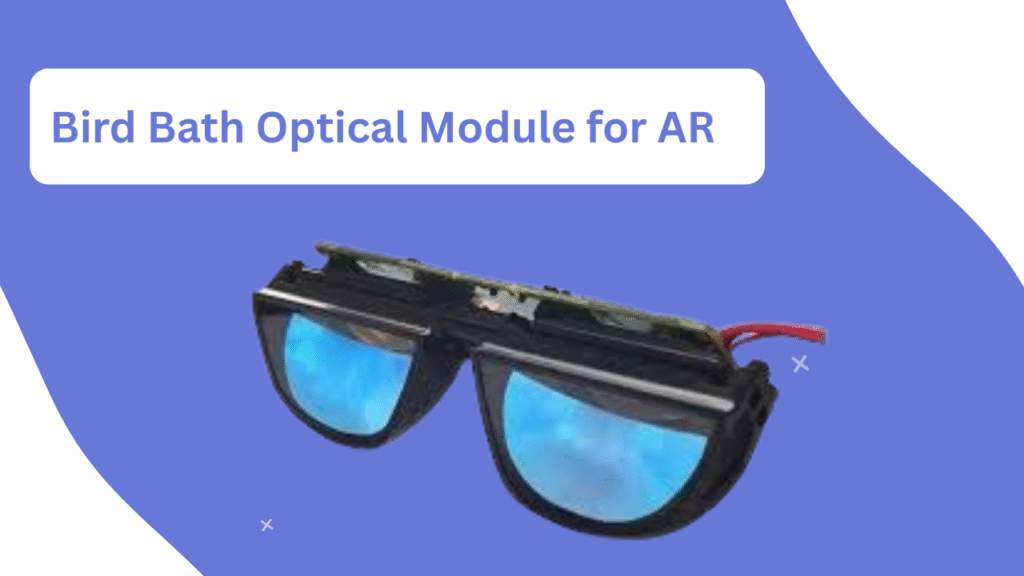The bird bath optical module is a key component in augmented reality (AR) display systems. It helps improve visual clarity, brightness, and image positioning in smart glasses and AR headsets. This module uses a combination of beam splitters, polarizers, and curved mirrors to guide light precisely to the user’s eyes. Its compact design makes it ideal for wearable devices where space is limited but performance is critical.
In this article, I will explain what a bird bath optical module is, how it works, and where it’s commonly used. You’ll also learn about its major benefits in AR development, such as improved image fidelity, reduced eye strain, and support for complex optical paths. Whether you’re an engineer, developer, or tech enthusiast, this guide will help you understand its value in today’s AR systems.
What Is a Bird Bath Optical Module?
A bird bath optical module is an optical structure that reflects and redirects light to create high-quality images in front of the user’s eyes. It is called a “bird bath” because its reflective elements are arranged in a rounded, bowl-shaped layout, similar to a birdbath.
The module often includes a curved mirror and a beam splitter or a polarizing beam splitter. These components work together to reflect and transmit light paths with minimal distortion. It is commonly used in near-eye displays where optical performance and compact design are essential.
How It Works in Augmented Reality
In AR systems, digital images are generated by microdisplays such as LCoS (Liquid Crystal on Silicon) or OLED panels. The bird bath optical module directs this light toward the user’s eyes using its mirrors and beam splitters. It overlays the digital information onto the real-world view without blocking the user’s surroundings.
By controlling light angles and polarization, the module ensures clear image delivery with minimal ghosting or color shift. The compact optical path design allows AR glasses to remain lightweight and wearable.
Common Applications in AR Systems
Bird bath optical modules are mainly found in:
- Smart Glasses: Used in enterprise or consumer-grade AR glasses for data overlays.
- AR Headsets: Integrated into larger head-mounted displays for immersive experiences.
- Training and Simulation: Enables realistic virtual overlays in professional training environments.
- Field Service Tools: Helps technicians view repair instructions without using hands.
These modules are often preferred when compact size and good brightness are needed without using complex waveguides.
Key Benefits of Bird Bath Optical Modules

Here are some important advantages:
- Compact Design: Fits easily into slim AR glasses.
- High Image Quality: Offers sharp images with good brightness and contrast.
- Low Cost: More affordable than advanced waveguide systems.
- Simple Assembly: Easier to integrate into devices with fewer alignment issues.
- Reliable Performance: Stable image performance across various environments.
This makes them a practical choice for early-stage or cost-sensitive AR devices.
Challenges and Limitations
Despite their benefits, bird bath optical modules do have some trade-offs:
- Bulky Appearance: While compact internally, the outward shape may appear bulky.
- Limited Field of View: Often provides a smaller display area compared to waveguides.
- Reflective Artifacts: May show some internal reflections if not well-coated or aligned.
These limitations are often accepted in exchange for affordability and ease of use.
Alternatives and Comparisons
Compared to waveguide optics and pancake lenses, bird bath modules are simpler and cheaper. Waveguides are thinner and offer a larger field of view but are costlier and harder to manufacture. Pancake optics offer a folded light path for ultra-compact displays but require complex polarization control.
Bird bath modules are a good balance of quality, size, and cost for mid-range AR applications.
Future Trends of Bird Bath Optics
As AR technology evolves, bird bath modules are also improving. Future versions may feature:
- Better Coatings: To reduce reflection losses.
- Integration with Microdisplays: For more compact AR glasses.
- AI-Powered Calibration: To auto-adjust alignment and brightness.
- Hybrid Systems: Combining bird bath optics with digital waveguides.
These upgrades could extend their use in more advanced AR platforms without raising costs significantly.
Conclusion
Bird bath optical modules are a vital part of many AR devices, offering a practical way to deliver digital visuals with clarity and precision. Their simple design, affordable cost, and proven performance make them ideal for both early-stage development and commercial AR products. While they have some limitations, their strengths often outweigh the downsides in many real-world scenarios.
If you’re developing or investing in augmented reality solutions, understanding how bird bath optics work can help you make smarter choices. Explore this technology further and see how it can enhance your AR projects with minimal complexity and cost.

